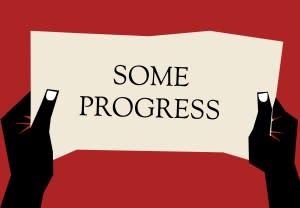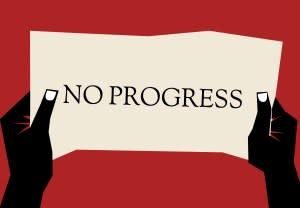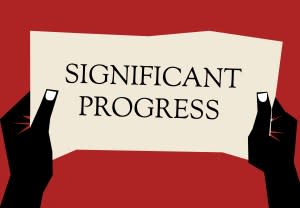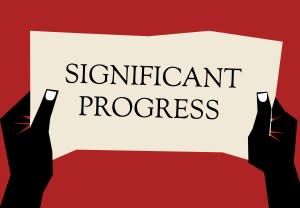Has Biden Kept His Campaign Promises to Black Americans? The Answer Is Complicated.

- Oops!Something went wrong.Please try again later.
- Oops!Something went wrong.Please try again later.
Black Americans were largely responsible for delivering the presidency to Joe Biden in 2020, and the debate over whether he’s delivered on his campaign promises is endless. Yet, with this year’s November showdown between him and former President Donald Trump steadily approaching, the options for us are limited.
Skepticism, confusion, and even pre-election fatigue are understandable. While the Biden administration has made moves toward lowering health care costs and banned federal law enforcement officers from using “no knock” entries and chokeholds, it’s seen much less progress in other areas. Many haven’t felt the impact of the administration wiping out $39 billion worth of student loan debt, and Black farmers feel left behind when it comes to Department of Agriculture debt relief assistance. And in recent months, Biden’s response to the war between Israel and Hamas that has killed tens of thousands of Palestinians in Gaza has turned off a growing number of voters.
So, how should we feel? Well, the answer is complicated. Keep in mind that Biden inherited a country still reeling from a pandemic that started during Trump’s presidency, racial uprisings set off by police killings of Black Americans, and an assault on multiracial democracy that occurred just weeks before his inauguration. And over the past few years, congressional gridlock has made it incredibly difficult to enact legislation on issues such as voting rights and police accountability.
But successfully articulating his administration’s policy wins to Black voters may be among his greatest challenges.
“The communication to Black communities about the administration’s accomplishments has fallen short,” says Adrianne Shropshire, the executive director of BlackPAC, an independent organization centered on political engagement. Referring to what she’s heard from focus groups BlackPAC has conducted, she says that “some people just have no idea what the administration has done, and that’s a big red flag heading into the election.”
As the 2024 contest heats up, Capital B created a handy progress report evaluating the extent to which Biden has followed through on key pledges regarding jobs and the economy, voting rights and equity, health care, criminal justice reform, and climate and infrastructure.
Overall, we found that the administration has done a lot, but more needs to be done to improve the lives of Black Americans. Read on for more.
Jobs and the Economy
Unemployment and Inflation

Promise made: The same month Biden was sworn into office, he inherited a rocky economy with a national 6.3% unemployment rate and at least 10 million officially unemployed workers, although this was a slight decrease from previous months. The Black unemployment rate was 9.2%, which was above the national average and the highest among other races.
Work done: To help ease the economic burden on families, Biden sent $1,400 checks to households and gave some support to small businesses of color through the American Rescue Plan Act of 2021. His administration also extended unemployment eligibility and benefits. From March 2021 to March 2022, the economy added 7.2 million jobs, with up to 4 million from the Rescue Plan, according to the Center for American Progress.
In early 2023, the Black unemployment rate was at historically low levels. Since then, the rate has continued to outpace the national average. The most recent report from the Bureau of Labor Statistics showed a national unemployment rate at 3.9%, while the Black unemployment rate stood at 5.6%, the highest among all races, with the unemployment rate for Black men steadily rising.
Read More: How ‘Bidenomics’ May Not Be Adding Up for Some Black Americans
When Biden took office, inflation increased every month, except during a few months in 2021. For nearly a year, inflation has consistently been on decline. Rural households and the South were hardest hit in 2021 and 2022, a January 2023 report from the Federal Reserve Bank of New York found. Price increases related to transportation, housing, and food contributed to the inflation patterns. Now, inflation is up again. A recent Consumer Price Index report found a 3.1% increase from a year earlier, with housing-related costs a major factor.
Climate Jobs

Promises Made: One of the four key components of President Joe Biden’s campaign was putting America “back in the business of leading the world on climate change.” And to do that, he said he’d bring the economy up with him by creating 10 million “good-paying union jobs” in clean energy by 2030. Preliminary federal plans outlined a 7% increase in jobs annually to achieve his goal, backed by a $2 trillion climate spending plan over four years.
“When I think about climate change,” he said on the campaign trail four months before being elected, “the word I think of is ‘jobs.’”
Work Done: Near the end of his term, Biden’s attention to increasing climate-friendly jobs has not wavered, though the results are not fully clear. Ultimately, Biden’s $2 trillion plan never made it through Congress. However, his administration has been able to pass three different major spending plans, which all included climate-related policies and programs.
Following his first year in office, clean energy job creation increased 5%, falling shy of his 7% goal, with the country seeing roughly 3.2 million people working in the clean energy industry in total. Without targeted policies, the increase in jobs does not necessarily favor Black workers, who make up just 8% of the industry.
But policies in Biden’s most expansive climate-related law, the Inflation Reduction Act, are expected to help increase jobs in the market exponentially. An analysis from the Political Economy Research Institute found that the law could create more than 9 million climate-friendly jobs over the next decade. And in September, Biden finally unveiled his American Climate Corps program, which rivals former President Franklin D. Roosevelt’s New Deal job programs. Still, the program meant to train youth in clean energy jobs is set to provide job training to just 20,000 people.
In all, more than 100,000 clean-energy jobs have been created over the past few years, but most still need to be filled, according to various climate policy groups. The employment shift depends on the waning of the country’s dependence on fossil fuels, which has been stunted by the administration’s various calls to increase production following a spike in gas prices in 2022. Since Biden took office, fossil fuel jobs have dropped by 7%.
Black Farmers

Promise made: On the campaign trail in 2020, Biden recognized the historical discrimination within the USDA’s programs, and advised the agency to take a “more proactive and equitable approach” to support training and resources for farmers of color. One proposal included ensuring rural residents receive equal access to government farm programs.
Work done: Only months into Biden’s term, he signed the American Rescue Plan Act into law, which included a $4 billion debt relief program for socially disadvantaged farmers and ranchers — which includes Black, Native American, Hispanic, and Asian communities. The program would have offered up to 120% of the outstanding indebtedness.
In June 2021, the same month the USDA planned to start loan payments to eligible borrowers, a judge issued a restraining order on the program in response to a lawsuit brought by a group of white farmers alleging that the debt relief program racially discriminated against them. This halted Biden’s efforts to address historical inequities and funding disparities by the USDA.
Rather than implement the existing loan forgiveness program, the Inflation Reduction Act, which was signed into law last year, replaced it with a $2.2 billion Discrimination Financial Assistance Program for all farmers and ranchers who experienced discrimination in USDA farm loan programs prior to 2021. All parties dismissed the lawsuit because of the new program in the Inflation Reduction Act. Black farmers, frustrated with the USDA and the Biden administration, filed a lawsuit hoping to get their promised relief, but a federal judge dismissed the case last summer.
“They have to know that this is a continuation of Jim Crow, and a continuation of what free Black men and women went through in this country. This is a continuation of that because we see it as another broken promise,” John Boyd Jr., president of the National Black Farmers Association, told Capital B in May.
Voting Rights and Equity
Voting Rights Act

Promise made: During a speech on July 28, 2020, outlining the racial equity dimension of his economic platform, Biden noted the importance of defending access to the ballot box.
“One thing the Senate and the president can do right away is pass the bill to restore the Voting Rights Act. Just yesterday, it was renamed in the Congress in memory of John Lewis. … Back it with some action. Protect that sacred right to vote that he was willing to die for. If they don’t, I’ve been saying all along, it’s one of the first things I’ll do as president if elected,” the then-presumptive Democratic nominee said.
Biden echoed these sentiments a month later, to mark the 55th anniversary of President Lyndon B. Johnson’s signing of the 1965 Voting Rights Act — one of the crown jewels of the Civil Rights Movement — into law.
“Every eligible voter should be able to vote and have it counted,” he said in a statement. “As president, I will work to enact the John Lewis Voting Rights Act. The battle for the soul for America has many fronts; the right to vote is the most fundamental.”
Work done: Biden’s efforts to make real progress on the voting rights front have been slow going, in part because getting legislation to his desk has been virtually impossible. Democrats enjoy only a slim majority in the U.S. Senate, and they lost their majority in the U.S. House of Representatives in the 2022 midterm elections.
As a result, much of the battle to secure access to the franchise has played out on the state level and in the U.S. Supreme Court. For instance, in a surprise decision, the high court last June upheld Section 2 of the Voting Rights Act, which protects against racial vote dilution.
Still, this isn’t to say that the president has done nothing to bolster voting rights.
Biden on Dec. 29, 2022, signed into law legislation overhauling the 1887 Electoral Count Act. A response to the siege of the U.S. Capitol on Jan. 6, 2021, the move, at its core, makes it more difficult to overturn a certified presidential election by clarifying and reforming the counting of electoral votes.
In addition, Biden on March 7, 2021, issued Executive Order 14019, a visionary executive order instructing federal agencies to “consider ways to expand citizens’ opportunities to register to vote and to obtain information about, and participate in, the electoral process.”
As has been well-documented, voting restrictions — and there’s been an uptick in these kinds of restrictions since the Supreme Court gutted Section 5 of the Voting Rights Act in 2013, and since former President Donald Trump lost the 2020 election — disproportionately burden Black communities.
Biden acknowledged in his 2024 campaign video that “MAGA extremists” continue to make it more difficult to vote, suggesting that voting rights will be a central plank of his reelection bid.
LGBTQ Rights

Promise made: LGBTQ rights haven’t figured prominently in survey data about Black Americans’ election priorities — but, to use today’s parlance, they matter.
Republican lawmakers across the U.S. have passed or introduced a record number of anti-LGBTQ bills this year. This legislative push has been accompanied by what the Human Rights Campaign calls an “epidemic of violence,” especially against Black transgender women
Numerous times on the campaign trail, Biden said that passing legislation protecting LGBTQ Americans, in particular the Equality Act, would be a priority should he win the White House. (Biden has long had fierce support in the community, given that in 2012, as vice president, he backed same-sex marriage even before former President Barack Obama did.)
Biden did triumph, of course. And in his victory address on Nov. 7, 2020, he embraced LGBTQ Americans — the first president to do so — and told his diverse coalition of supporters that he’d have their back.
Work done: Passing the Equality Act has hit a snag, given that Democrats control only one chamber of Congress. Biden has advanced LGBTQ rights in other ways, though.
Consider that, on Dec. 13, 2022, Biden signed the Respect For Marriage Act, which the HRC described as “the biggest legislative win in the fight for LGBTQ equality in over a decade, guaranteeing federal rights, benefits and obligations of marriages in the federal code for same-sex couples.”
On Feb. 23, 2021, following the president’s orders, the U.S. Department of Veterans Affairs announced that it was expanding its support for transgender veterans.
And on Jan. 25, 2021, he repealed the ban on transgender military service.
Diversity on the Bench

Promise made: President Joe Biden made a pledge to diversify the federal bench after the death of Supreme Court Justice Ruth Bader Ginsberg in September 2020, and has more than exceeded expectations. Not only has Biden chosen more women as well as ethnic and racially diverse nominees than any other president, he has also picked those with experience as public defenders and civil rights, legal aid, and election and voting rights lawyers.
Work done: As of March, 190 judicial nominees have been confirmed by the Senate.
In addition to those 41 circuit and 146 district court lifetime appointments was the historic nomination of Ketanji Brown Jackson as the first Black woman to serve on the U.S. Supreme Court. Biden also tied the number of confirmed LGBTQ judges and broke the record of appointing more Black judges in one term than any other president in history.
Of the confirmed judges, 122 are women, 58 are Black, 35 Latino/Latina, and 33 Asian American and Pacific Islander. More than a dozen practiced civil rights law. There were37 public defenders, eight labor attorneys, 69 prosecutors, and 107 sitting judges, according to a spokeswoman for Sen. Dick Durbin, the majority whip and chair of the Senate Judiciary Committee.
Biden’s nomination streak isn’t over. He announced his 46th round of nominations in February.
Health Care
Affordable Health Care

Promise made: Biden’s administration has said it’s committed to lowering the price of health care, including lowering insurance premiums, deductibles, out-of-pocket expenses and spending, and surprise billing.
“I’m going to lower prescription drugs by 60%,” he said during a campaign speech in the fall of 2020.
Work done: The Inflation Reduction Act was a critical piece of legislation in terms of addressing the cost of prescription drug prices. The Congressional Budget Office estimates that it will reduce the federal deficit by $237 billion by 2031. The new law now requires the federal government to negotiate drug prices for some of the highest priced, Medicare-covered drugs with no competitors. Previously, the federal government was denied such negotiation power.
Another provision limits those on Medicare from spending more than $2,000 for certain drugs, which helps the sickest patients battling complex conditions such as cancer. Some of the provisions have started to be phased in. A major caveat is that private insurance wasn’t included in the law.
In January, the same act imposed a $35 monthly cap on the out-of-pocket cost of insulin for seniors enrolled in Medicare. Adding a cap for those using private insurance was an issue hotly debated on the Senate floor, but it did not get through. Still, the move by the administration encouraged one drug manufacturer to follow suit.
Reproductive Health

Promise made: The Biden administration committed to protecting Black maternal health. It’s a policy issue largely championed by Vice President Kamala Harris, who has promised to address the crisis through improved maternal health care infrastructure and access. On the 2020 campaign trail, Biden pledged to codify Roe v. Wade, and he doubled down on his commitment to securing access to abortion care following the decision last year by the Supreme Court to overturn the 1973 ruling.
Work done: Biden doesn’t have enough congressional votes to codify Roe, but in the months since, he’s taken steps to protect access to reproductive health care, including calling on the Supreme Court to stop restrictions on medication abortion from taking effect.
With the status of abortion access largely in states’ hands, the threats to access are ongoing, as those mostly congregated in the Southeast, where more than half of the country’s Black population resides, implement increasingly strict bans. The White House is defending itself against lawsuits aimed at curbing federal protections of abortion access.
And though the administration has committed itself to improving the maternal health crisis that leaves Black families most vulnerable, the abortion bans could exacerbate death rates that are on the rise. At the same time, the number of labor and delivery units, particularly in rural communities across the country, are dwindling, forcing families to travel great distances for care, increasing the chance of complications. Still, the number of states expanding postpartum Medicaid coverage to a full year after delivery is a victory for the administration.
Related: Black Women Are Losing Access to Maternity Care. This Law Is Partly to Blame.
Rural Hospitals

Promise made: On the campaign trail and into his presidency, Biden has consistently said he’s going to rebuild rural America, and in part, help “end the rural health care crisis.” His plan included increased funding for community health centers, grant funding to build rural hospitals, and enhanced telehealth services.
Work done: In the American Rescue Plan, the administration ushered $500 million to the USDA to create the Emergency Rural Health Care Grant program. At least $350 million of that helped rural hospitals and communities increase COVID-19 testing, telehealth, and food assistance, and purchase medical supplies and construct or renovate health facilities. An added $8.5 billion was allocated to reimburse rural health providers for health care costs related to the pandemic. The Department of Health and Human Services distributed an additional $20 million to strengthen telehealth services in rural and underserved areas.
While the funding has been essential to keep hospitals afloat, the federal relief is drying up, forcing health care providers to cut services or close in an effort to combat rising prices, staffing shortages, and revenue losses. Some rural hospitals across majority Black areas in rural North Carolina closed last year. Many more like Greenwood Leflore Hospital in the rural Mississippi Delta are still struggling. More than 600, or 30% of all rural hospitals nationwide, are at risk of closing.
Cancer

Promise made: In 2016, as vice president, Joe Biden launched the cancer moonshot initiative, which would put policy in place to cut the cancer death rate by at least 50% over the next 25 years. On entering the White House, he reignited the mission, which pledged to improve access to cancer screenings, and committed to investing in the development of new drugs, smoking cessation, and addressing inequities.
Work done: The bulk of the work being done by the Biden administration to address the high rates of cancer deaths has been aimed at increasing funding for screenings and research. There have also been a number of pushes from the Food and Drug Administration to update tobacco rules and regulations. On taking office, Biden formed and convened a Cancer Cabinet that brings together agencies across the federal government to create an agenda for addressing the crisis, including hosting roundtable discussions.
A number of federal agencies, including the Centers for Disease Control and Prevention and Health Resources and Services Administration, have awarded millions in grant funding to improve prevention through cancer screening programs across the United States. Other money has gone toward reducing environmental and toxic exposures, as well as research.
Tobacco has been a focal point of the FDA in recent years. The agency has proposed a number of rules that could significantly reduce tobacco-related illness and death, including improving the consistency of tobacco product manufacturing and ingredient transparency. Some of the proposals, such as the potential ban on menthol cigarettes, have faced backlash around what exactly its impact on Black communities would look like. In 2022, the agency also released new guidance on diversifying clinical trials for cancer to include patients ages 65 and older, though this doesn’t address racial disparities. For most cancers, Black Americans’ death rates are higher than other racial groups, and their survival rates are lower.
Criminal Justice Reform
Police Accountability

Promise made: Following the May 2020 murder of George Floyd, Democratic members of Congress crafted a large police reform bill that would, among other things, end qualified immunity for police officers, ban the use of chokeholds, and create a national police misconduct database. Biden pledged to sign the George Floyd Justice in Policing Act as soon as it passed the Senate, and he proposed creating a police oversight commission.
Work done: More than two years into the Biden presidency, the Floyd Act is still floundering in the Senate, despite Biden’s repeated calls to Congress to pass it, and plans for a commission have been put on hold.
However, in May 2022, two years after Floyd’s death, Biden signed a police accountability executive order that requires federal law enforcement agencies to ban chokeholds; restrict no-knock warrants; mandate the use of body-worn cameras; implement stronger use of force policies, including the duty to intervene and duty to render medical aid; submit officer misconduct records into a new national database; and restrict the transfer of military equipment to local law enforcement agencies.
Though Biden can’t order local and state law enforcement agencies to comply with these orders, there are incentives for agencies that have or will make these changes. Prior to the executive order, local jurisdictions such as Louisville, Kentucky, implemented reforms for their police department that included changes to their warrant policies following the March 2020 death of Breonna Taylor.
A 2023 report from Gallup’s Center on Black Voices revealed about 56% of Black Americans reported feeling confident in local law enforcement, yet 73% said they want major changes to policing.
Despite the Justice Department’s recent launch of the National Law Enforcement Accountability Database and its civil rights division resuming pattern or practice investigations, these announcements have done little to put Black Americans at ease.
Clemency

Promise made: When Biden campaigned for president in 2020, he pledged to address the mistake of supporting the 1994 crime bill that increased the incarceration rate of Black and Latino people.
Work done: Within Biden’s first two years, he broke away from a long streak of presidents who didn’t use their executive powers to grant clemency, pardons, or commutations earlier in their terms. Those with the executive power to make these decisions — the president, governors — usually wait until the end of their term or around the holiday season to make an announcement.
In April 2022, Biden granted commutations to 75 nonviolent drug offenders and pardoned three federally incarcerated people. April is now known as Second Chance Month.
In October 2022, Biden pardoned simple marijuana possession convictions for 6,000 people — none were incarcerated at the time of the announcement. In April 2023, Biden commuted the sentences of 31 people serving home confinement, under the CARES Act, for nonviolent drug convictions.
There are thousands of clemency applicants pending, including hundreds for people serving lengthy sentences because of federal crack cocaine sentencing guidelines. The Anti-Drug Abuse Act of 1986 made it so that someone convicted for a small amount of crack would face the same punishment as if the drug was a larger amount of powder cocaine.
This policy resulted in a sentencing disparity, and Black people were policed more aggressively than any other group, according to a letter sent to the White House in June 2023 from the ACLU, NAACP Legal Defense and Educational Fund, The Sentencing Project, and other anti-mass incarceration organizations calling on Biden to grant clemency to people with federal crack convictions.
By the end of 2023, the U.S. Justice Department announced improvements to the clemency process that includes hiring more staff to sift through the backlog to deny or approve an application sooner.
Climate and Infrastructure
Emission Reductions and Elevating Environmental Injustice

Promises Made: On the campaign trail, Biden vehemently vowed to be the nation’s first climate president. The cornerstone of that plan depended on a dramatic decrease in pollution from domestic sources, but he said it had to be done in an equitable way to reverse decades of racist policies that left Black people most exposed to dirty air and water.
He campaigned to slash greenhouse gas emissions by 50% by 2030 through various measures primarily focused on transportation and power plant pollution. To ensure environmental justice, his campaign set a goal that 40% of all clean energy spending would go to “disadvantaged communities.”
He went as far as to say climate change was the “number one issue facing humanity” and “the number one issue for me.” No one in America, he said, was “going to build another oil or gas-fired electric plant.”
Work Done: In the first year of Biden’s presidency, there were, in fact, dozens of new gas-fired electric plants built. And according to a 2022 analysis from the U.S. Energy Information Administration, over the next few years, the U.S. is expected to build around 17 gigawatts of fossil-fueled gas plants.
Still, the administration has successfully passed two measures, the Bipartisan Infrastructure Law and the Inflation Reduction Act, and proposed pollution cuts through the EPA. Industry projections say recent moves will reduce pollution by anywhere from 26% to 42%. Biden’s EPA has also introduced pollution reduction plans related to particulate matter and a plan to cut the pollution spewed out by 218 of the country’s largest oil and chemical plants.
On the transportation front, the administration has outlined nearly $10 billion in funding to encourage Americans to switch to electric-powered cars, while the auto industry has invested more than $120 billion in electric vehicles during his presidency.
Read More: Will the Electric Vehicle Push Bring Black Americans Along on the Ride?
As Capital B has reported, however, the push has led to adverse effects in Black communities, some of which have been overburdened and harmed by the shift’s requirement for new infrastructure to be built and by pollution related to increased car production.
As for his staple policy known as Justice40, which directs 40% of climate spending to reach disadvantaged communities, the results are less defined. Initially, the White House blew by deadlines related to the program, such as releasing its screening tool meant to identify the communities most in need of such investments.
Since then, however, Biden has doubled down on combating environmental injustice with the new Environmental Justice for All executive order, which requires federal agencies to notify communities if toxic substances are released from a federal facility.
Broadband Access

Promise made: The digital divide has been an issue for decades, especially burdening Black communities who are less likely to have broadband availability. As President-elect, Biden advocated for universal broadband for all. His administration invested $20 billion to build infrastructure in rural areas and expand existing programs that subsidize internet and phone services for low-income individuals.
Work done: Through the American Rescue Plan Act and the Bipartisan Infrastructure Law, both signed into law in 2021, his administration poured in billions of dollars to help Americans afford and connect to high speed, reliable internet. The American Rescue Plan provided $20 billion toward programs that provided emergency assistance through monthly stipends for discounts on broadband to households, help libraries and students afford devices, or support work, education, and health projects affected by the digital divide, the Brookings Institution analyzed.
The Bipartisan Infrastructure Law invested about $65 billion in three programs — the Broadband Equity, Access, and Deployment Program; the Enabling Middle Mile Broadband Infrastructure Program; and the State Digital Equity Act. Despite an unprecedented amount of funds, it still isn’t enough to solve the digital divide. At least 42 million Americans still lack access to the internet, estimates BroadbandNow. Capital B reported extensively on the challenges, which stem from years of limited federal funding, digital redlining, lack of infrastructure investment, and inaccurate data on broadband availability.
Capital B Staff Writers Brandon Tensley, Aallyah Wright, Margo Snipe, Christina Carrega, and Adam Mahoney contributed to this report.
The post Has Biden Kept His Campaign Promises to Black Americans? The Answer Is Complicated. appeared first on Capital B News.

